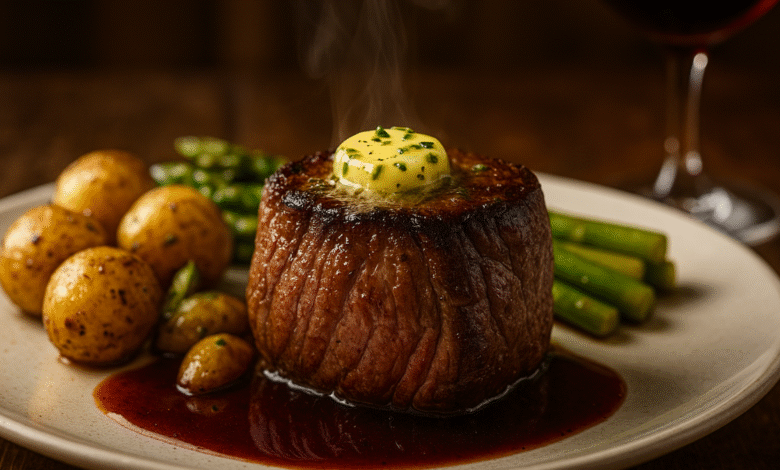Filet Mignon: The Ultimate Guide to a Legendary Cut

Discover the ultimate guide to filet mignon—tender, elegant, and flavorful. Learn its origins, cooking tips, pairings, nutrition, and expert secrets to enjoy this legendary cut.
Filet mignon is often considered the crown jewel of beef cuts. Known for its tenderness, subtle flavor, and melt-in-your-mouth texture, it has become a favorite in steakhouses and home kitchens alike. Despite being one of the smallest portions from the tenderloin, it carries a reputation far larger than its size.
What makes filet mignon so special is not just its buttery tenderness but also the fact that it represents luxury on a plate. Whether served with a peppercorn sauce, wrapped in bacon, or simply seared in butter, this cut embodies culinary sophistication. But there is much more to it than just being a “fancy steak.”
Understanding the Origins of Filet Mignon
The term filet mignon comes from French, where filet means “thick slice” and mignon translates to “dainty” or “cute.” This definition is a perfect reflection of the cut’s size and delicacy. Unlike ribeye or sirloin, which come from larger, tougher parts of the cow, filet mignon is taken from the tenderloin—a muscle that does very little work, giving it unmatched tenderness.
Historically, filet mignon was a prized cut reserved for special occasions in Europe. When it made its way into American dining culture, it quickly became the highlight of luxury menus, associated with fine dining experiences. Its exclusivity stems from the fact that each cow yields only a small portion of tenderloin, making filet mignon both rare and valuable.
Why Filet Mignon Is the Most Tender Cut
What sets filet mignon apart from other steaks is its unique muscle structure. The tenderloin, where filet mignon is located, is tucked inside the short loin and sirloin section of the cow. Because this muscle does not bear much weight or engage in heavy movement, it develops almost no connective tissue, resulting in unmatched tenderness.
Compared to cuts like strip steak or ribeye, filet mignon contains very little marbling. This gives it a mild flavor, which is why many chefs enhance it with sauces, compound butters, or bacon wrapping. While ribeye is known for its bold, fatty taste, filet mignon shines for its silky texture.
“If ribeye is about flavor, filet mignon is about finesse.”
Cooking Filet Mignon to Perfection
Preparing filet mignon requires a different approach than other cuts because of its delicacy. Overcooking can easily ruin its soft texture, so precision is key. Chefs often recommend cooking it rare to medium-rare for the best experience.
Popular cooking methods include:
- Pan-searing and oven-finishing: Start with a hot sear in butter and garlic, then finish in the oven.
- Grilling: Perfect for adding smoky notes while maintaining tenderness.
- Sous-vide: Ensures a precise, even cook before finishing with a quick sear.
Seasoning should remain simple—salt, pepper, and perhaps a touch of rosemary or thyme. Because filet mignon is naturally tender, it doesn’t need heavy marinades. Instead, light seasonings and a touch of butter elevate its natural character.
Pairing Filet Mignon with Sauces and Sides
Filet mignon pairs beautifully with a wide variety of sauces and accompaniments. Because it has a mild flavor, sauces bring out its best qualities. Classic choices include:
- Béarnaise sauce
- Red wine reduction
- Peppercorn cream sauce
- Garlic herb butter
As for sides, rich yet balanced accompaniments make the meal unforgettable. Think roasted garlic mashed potatoes, grilled asparagus, sautéed mushrooms, or a fresh arugula salad. These pairings enhance filet mignon’s luxurious profile without overpowering it.
Filet Mignon vs Other Popular Steaks
| Cut | Tenderness Level | Flavor Profile | Marbling | Best Cooking Method |
|---|---|---|---|---|
| Filet Mignon | Extremely Tender | Mild, delicate | Low | Pan-sear, grill, sous-vide |
| Ribeye | Moderately Tender | Rich, beefy, fatty | High | Grilling, cast iron |
| New York Strip | Tender | Bold, moderately fatty | Medium | Grilling, broiling |
| Sirloin | Less Tender | Strong beef flavor | Medium | Grilling, pan-searing |
This comparison shows that filet mignon is unrivaled in tenderness, but not in flavor. That’s why chefs often combine it with sauces or pair it with richer side dishes.
Nutritional Value of Filet Mignon
Filet mignon may be indulgent, but it is also leaner than many other cuts of steak. A typical serving (around 6 ounces) provides:
- Calories: ~320
- Protein: ~46g
- Fat: ~14g
- Saturated Fat: ~6g
- Iron: 15% of daily value
- Zinc: 40% of daily value
Because it is lower in fat compared to ribeye or porterhouse, filet mignon appeals to those looking for a lean yet indulgent steak option. It is also protein-rich, making it suitable for high-protein diets.
Best Wine Pairings with Filet Mignon
A luxurious steak deserves a wine pairing that elevates the entire meal. Filet mignon’s subtle flavor works beautifully with medium-bodied wines that enhance without overwhelming:
- Pinot Noir: Soft tannins match filet’s delicacy.
- Cabernet Sauvignon: A bolder choice that adds depth.
- Merlot: Smooth and versatile.
- Syrah/Shiraz: For those who enjoy a peppery kick.
The right wine creates harmony on the palate, balancing the buttery texture of filet mignon with complex notes of fruit and spice.
Myths and Misconceptions About Filet Mignon
Despite its popularity, filet mignon carries a few misconceptions. Some believe it lacks flavor compared to fattier cuts, but that’s not entirely true. While it is less marbled, its delicate nature makes it ideal for pairing with bold sauces.
Another myth is that filet mignon is always expensive. While it is one of the priciest cuts at steakhouses, home cooks can often find tenderloin portions at butcher shops for a more reasonable cost. Learning how to cook it properly at home can deliver the same fine-dining experience at a fraction of the price.
Frequently Asked Questions About Filet Mignon
Q1: What makes filet mignon different from tenderloin?
Filet mignon is a portion of the tenderloin, specifically cut from the smaller end. While the entire tenderloin is tender, filet mignon is the most prized section due to its size and delicacy.
Q2: Is filet mignon healthy?
Yes, filet mignon is a lean cut of beef with high protein content. It contains less fat compared to ribeye or T-bone, making it a healthier indulgence for steak lovers.
Q3: How should I season filet mignon?
Keep it simple. A touch of salt, cracked black pepper, and maybe a sprig of rosemary is all you need. Heavy marinades are unnecessary since the cut is naturally tender.
Q4: Can filet mignon be grilled?
Absolutely. Grilling gives it a smoky flavor while keeping its signature tenderness. Just be careful not to overcook it, as its lean nature means it can dry out quickly.
Q5: Why is filet mignon wrapped in bacon sometimes?
Because filet mignon has low fat content, wrapping it in bacon adds extra flavor and juiciness, while also preventing the steak from drying out during cooking.
Conclusion
Filet mignon is more than just a steak—it is an experience. From its buttery tenderness to its elegance on the plate, this cut has earned its reputation as a symbol of luxury and fine dining. Whether enjoyed at a high-end restaurant or cooked with care at home, filet mignon delivers an unforgettable culinary journey.
Its subtle flavor allows for endless creativity with sauces, sides, and wine pairings, making it a versatile yet refined choice. For anyone seeking the perfect blend of tenderness and sophistication, filet mignon will always stand as the gold standard of steaks.





